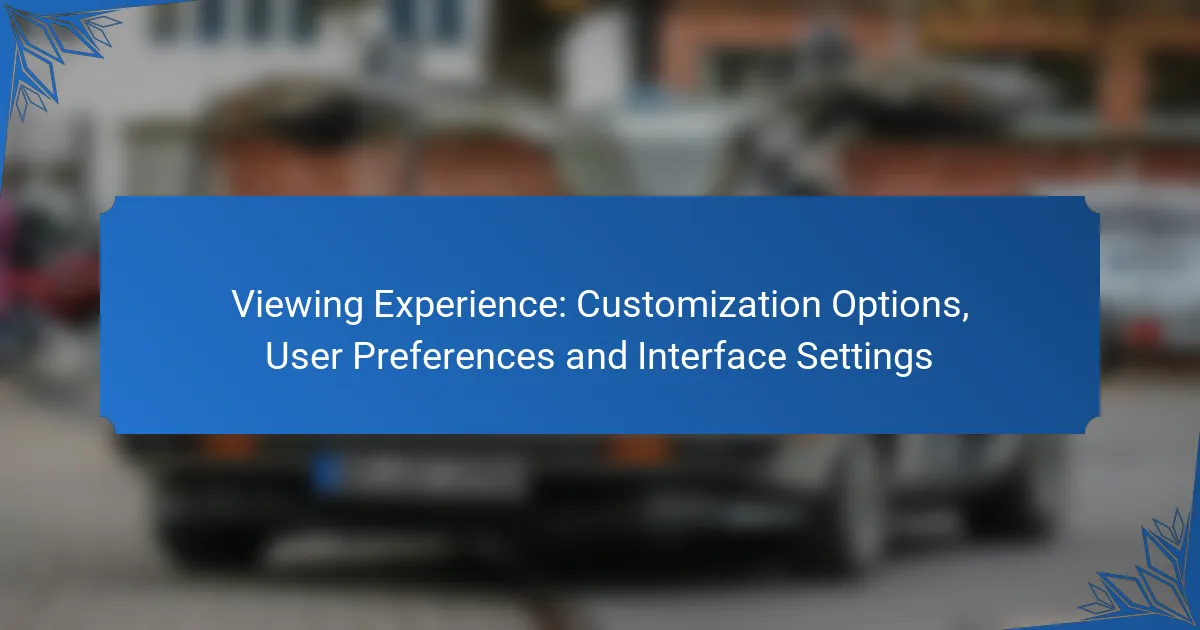Enhancing the viewing experience through customization options allows users to create a personalized environment that suits their individual preferences. Features such as adjustable screen brightness, font size, and customizable layouts contribute significantly to user comfort and engagement. By tailoring interface settings and navigation, users can enjoy a more intuitive and satisfying media consumption experience.

What customization options enhance viewing experience?
Customization options that enhance the viewing experience include adjustable screen brightness, color calibration settings, font size and style adjustments, aspect ratio settings, and customizable layouts. These features allow users to tailor their viewing environment to their preferences, improving comfort and engagement.
Adjustable screen brightness
Adjustable screen brightness is essential for optimizing visibility based on ambient lighting conditions. Users can typically find brightness controls in the display settings of their devices, allowing them to increase brightness in well-lit environments or decrease it in darker settings to reduce eye strain.
When adjusting brightness, consider using automatic settings that adapt to surrounding light. This can enhance battery life on portable devices and provide a consistent viewing experience throughout the day.
Color calibration settings
Color calibration settings enable users to adjust the color balance and saturation of their screens for more accurate and pleasing visuals. This is particularly important for tasks that require color precision, such as graphic design or photo editing.
Many devices offer preset color profiles, but users can also manually adjust settings like contrast and gamma. Regular calibration can help maintain color accuracy over time, especially for displays that are frequently used.
Font size and style adjustments
Font size and style adjustments allow users to enhance readability according to their preferences. Larger fonts can reduce eye strain, while different styles can improve clarity and personal comfort.
Most operating systems and applications provide options to change font settings easily. Users should experiment with various sizes and styles to find what works best for their reading habits, especially in text-heavy environments.
Aspect ratio settings
Aspect ratio settings determine how content is displayed on the screen, affecting the overall viewing experience. Users can adjust the aspect ratio to match the content format, whether it’s widescreen movies or standard television shows.
Choosing the correct aspect ratio can prevent distortion and ensure that images and videos are presented as intended. Common ratios include 16:9 for widescreen and 4:3 for traditional formats, so users should select based on the media they consume most frequently.
Customizable layouts
Customizable layouts allow users to arrange on-screen elements according to their preferences, enhancing usability and efficiency. This feature is particularly beneficial for multitasking, as users can organize windows and applications to suit their workflow.
Many applications and operating systems support drag-and-drop functionality for layout adjustments. Users should take advantage of these features to create a personalized workspace that maximizes productivity and comfort during extended viewing sessions.

How do user preferences impact viewing experience?
User preferences play a crucial role in shaping the viewing experience by allowing individuals to tailor content and interface settings to their liking. These customizations enhance user satisfaction and engagement, making it easier to consume media in a way that feels comfortable and enjoyable.
Personalized content recommendations
Personalized content recommendations use algorithms to analyze user behavior, preferences, and viewing history to suggest relevant shows or movies. This can significantly enhance the viewing experience by presenting options that align with individual tastes, potentially increasing engagement and satisfaction.
For instance, streaming platforms often categorize content based on genres, themes, or user ratings, allowing users to discover new favorites. Users should regularly update their preferences and ratings to improve the accuracy of these recommendations.
User interface themes
User interface themes allow users to customize the look and feel of their viewing platform, impacting overall enjoyment. Options may include dark mode, light mode, or various color palettes, catering to different aesthetic preferences and lighting conditions.
Choosing a theme that reduces eye strain or enhances readability can improve the viewing experience, especially during extended sessions. Users should explore available themes in their settings and select one that best suits their environment and personal comfort.
Accessibility features
Accessibility features ensure that all users, including those with disabilities, can enjoy content effectively. These features may include closed captions, audio descriptions, and adjustable text sizes, making media more inclusive.
When selecting a viewing platform, users should look for robust accessibility options that meet their needs. Regularly checking for updates on these features can also enhance the viewing experience for everyone, ensuring that no one is left behind.

What interface settings improve usability?
To enhance usability, interface settings should focus on personalizing user experiences, making navigation intuitive, and minimizing distractions. Customization options like navigation menu adjustments, shortcut key configurations, and notification settings play a crucial role in achieving this goal.
Navigation menu customization
Customizing the navigation menu allows users to prioritize the features they use most frequently, improving overall efficiency. Users can often rearrange, add, or remove menu items based on their preferences, which helps streamline their workflow.
For example, a user might choose to place the ‘Favorites’ section at the top of the menu for quicker access. It’s essential to regularly review and update these settings as usage patterns change to maintain optimal usability.
Shortcut key configurations
Shortcut key configurations enable users to execute commands quickly, reducing reliance on mouse navigation. Most applications allow users to assign or modify keyboard shortcuts to suit their workflow, which can significantly speed up task completion.
For instance, a user can set ‘Ctrl + N’ to open a new document or ‘Alt + S’ to save changes. Familiarizing oneself with these shortcuts can lead to a more efficient and enjoyable experience, especially for power users.
Notification settings
Adjusting notification settings helps users manage distractions and maintain focus. Users can typically choose to enable or disable notifications for specific applications or set them to ‘Do Not Disturb’ during critical work periods.
For example, turning off non-essential notifications during meetings can prevent interruptions. It’s advisable to periodically review these settings to ensure they align with current priorities and tasks, allowing for a more tailored and productive environment.

What are the best practices for optimizing viewing experience?
To optimize the viewing experience, it is essential to focus on software updates, user feedback, and testing configurations. These practices ensure that the interface remains user-friendly, responsive, and tailored to individual preferences.
Regular software updates
Regular software updates are crucial for maintaining an optimal viewing experience. They often include performance enhancements, bug fixes, and new features that improve usability. Users should set their systems to automatically update or check for updates frequently to ensure they benefit from the latest improvements.
Consider scheduling updates during off-peak hours to minimize disruption. For instance, updating software late at night or during weekends can help maintain productivity while ensuring the system is up-to-date.
Utilizing user feedback
Utilizing user feedback is vital for understanding preferences and pain points. Gathering insights through surveys, focus groups, or direct feedback can highlight areas needing improvement. This information helps developers prioritize features that enhance the viewing experience.
Implementing a feedback loop, where users can continuously share their experiences, fosters a more responsive interface. Regularly reviewing this feedback allows for timely adjustments that align with user expectations.
Testing different configurations
Testing different configurations is essential for identifying the optimal settings for various user environments. This may involve adjusting display settings, resolution, or interface layouts to see what works best for different devices and user preferences. A/B testing can be particularly effective in comparing two or more configurations to determine which yields a better viewing experience.
Encourage users to experiment with settings like brightness, contrast, and text size to find their ideal setup. Providing clear instructions on how to make these adjustments can empower users to customize their viewing experience effectively.

What tools can help customize viewing experience?
Several tools can significantly enhance your viewing experience by allowing customization based on personal preferences and needs. These tools range from display calibration to user interface design software, each serving a unique purpose in tailoring the visual output to individual requirements.
Display calibration tools
Display calibration tools help adjust the color, brightness, and contrast settings of screens to ensure accurate and pleasing visuals. These tools can be hardware-based, like colorimeters, or software-based, which guide users through the calibration process.
Common calibration tools include software like CalMAN and DisplayCAL, which can help achieve industry-standard color accuracy. Users should consider their specific needs; for instance, professional photographers may require more precise calibration than casual viewers.
User interface design software
User interface design software allows for the customization of layouts and elements to enhance usability and aesthetics. Tools such as Adobe XD and Figma enable users to create tailored interfaces that meet their specific viewing preferences.
When selecting UI design software, consider factors like collaboration features and ease of use. For example, Figma is popular for its real-time collaboration capabilities, making it ideal for teams working on interface projects.
Accessibility testing tools
Accessibility testing tools ensure that content is usable for individuals with disabilities, enhancing the overall viewing experience. Tools like WAVE and Axe can identify accessibility issues, such as color contrast problems or missing alt text for images.
Using these tools helps comply with accessibility standards like WCAG, which aim to make digital content more inclusive. Regular testing with these tools can prevent potential barriers and improve user satisfaction across diverse audiences.

How do different devices affect viewing experience?
Different devices significantly influence the viewing experience by affecting screen size, resolution, and user interface. For instance, larger screens typically provide a more immersive experience, while mobile devices offer convenience and portability.
Screen Size
Screen size plays a crucial role in how content is consumed. Larger screens, such as TVs or monitors, allow for more detailed visuals and a more engaging experience, especially for movies and gaming. In contrast, smaller devices like smartphones may require zooming or scrolling, which can disrupt the flow of content consumption.
When choosing a device, consider the primary use case. For example, if watching films or playing games is a priority, a larger screen is preferable. For casual browsing or social media, a smartphone may suffice.
Resolution
Resolution impacts clarity and detail in the viewing experience. Higher resolutions, such as 4K, provide sharper images and more vibrant colors, enhancing the overall enjoyment. Devices with lower resolutions may result in pixelation or blurriness, particularly on larger screens.
When selecting a device, aim for at least Full HD (1080p) for a satisfactory experience. For high-definition content, consider devices that support 4K resolution to fully appreciate the visual quality.
User Interface
The user interface (UI) affects how easily users can navigate and interact with content. Devices with intuitive UIs, such as smart TVs or tablets, enhance the viewing experience by making it easier to find and control content. Conversely, complicated interfaces can lead to frustration and hinder enjoyment.
When choosing a device, prioritize those with user-friendly interfaces. Look for features like voice control or touch screens that simplify navigation and improve accessibility.
Connectivity Options
Connectivity options determine how devices access content. Devices that support various streaming services or have multiple input options, such as HDMI or USB-C, offer greater flexibility. This allows users to connect different media sources, enhancing the viewing experience.
Consider devices that offer both wired and wireless connectivity. For example, a smart TV with Wi-Fi capability allows for easy access to streaming services, while HDMI ports enable connections to gaming consoles or Blu-ray players.


